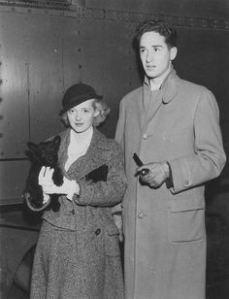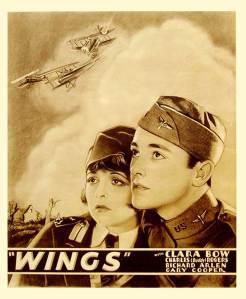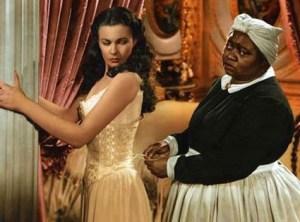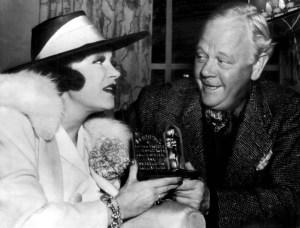The Academy of Motion Picture Arts and Sciences (AMPAS) was founded by MGM head honcho Louis B. Mayer in 1927 mostly for the express purpose of establishing an agency to deal with all of the various labor unions. However, as it turns out mediating endless labor disputes suuuuuuuuucked. So, Douglas Fairbanks, Sr., the first AMPAS president, steered the Academy away from labor and toward self-congratulation, establishing the Academy Awards. Thanks to his efforts, we are now bracing for the 86th Academy Awards. Last year, we openly wondered why it is that we allow ourselves to get worked up by such a silly awards show. This year, we’re in more of a trivia mood. So, here are 10 things you may not know about the Academy Awards:
1. Oscar isn’t really an Oscar.
For years, people have been calling the Academy Awards the Oscars, and last year the Academy made it quasi-official, re-branding itself in all marketing materials as “The Oscars.” Instead of touting itself as the 85th Academy Awards Ceremony it was simply The Oscars, a re-branding which has carried over into this year’s ceremony. The name Oscar, of course, comes from the nickname attributed to the statuette awarded to all winners. However, those statues aren’t even officially called Oscars. Nope. Their official description is “Academy Award of Merit.”
2. Where did the name “Oscar” even come from?

Bette Davis and first husband Harmon Oscar Nelson
Short answer: no one knows for sure; long answer: there are 3 possibilities. The most commonly accepted among them is that upon seeing the statue for the first time academy librarian Margaret Herrick remarked that it looked like her uncle Oscar. Similar stories with less merit are that Bette Davis observed the statue resembled her husband Harmon Oscar Nelson (whom she divorced after winning her first 2 Oscars), and newspaper columnist Sidney Skolsky assigned the name because it sounded less pretentious than “Academy Award of Merit.” Either way, Oscar was officially adopted as the nickname for the statue in 1939.
3. Why a bald man holding a sword?
 on October 19, 2009 in Santa Clarita, California." /> on October 19, 2009 in Santa Clarita, California. on October 19, 2009 in Santa Clarita, California."
on October 19, 2009 in Santa Clarita, California." /> on October 19, 2009 in Santa Clarita, California. on October 19, 2009 in Santa Clarita, California."
Cedric Gibbons, the art director for MGM, designed the statuette as a representation of a knight standing on a reel of film while holding a sword. George Stanley sculpted the statue based off of Gibbons’ design, with Stanley receiving $500 for his efforts. Gibbons would actually win 11 of his own Oscars for his work in various films between 1930 and 1956.
4. Were there enough spare raw materials to make the statuettes during WWII?

No. The original Oscars were gold-plated bronze standing atop a Belgian black marble. During WWII, the Oscars were made of plaster, although after the war everyone who had received a plaster Oscar was awarded a more standard metal one as replacement.
5. Only 14 awards were given out at the first ceremony
There are currently 24 different categories for the Oscars, but there were only 14 categories at the time of the inaugural ceremony. The only categories which have survived more or less unchanged to the present are Best Actor, Actress, Cinematography, Writing (Adaptation & Original), and Art Direction (which was re-named Production Design in 2012). At the original ceremony, the Best Picture and Best Director categories were split into two for the first and only time. So, there was an award for Outstanding Picture AND Unique and Artistic Picture, and the directors were divided between comedic and dramatic films. There was also an additional writing category (title writing) and a technical category (Engineering Effects) which were discontinued after the first year. The original ceremony also had 2 special achievement awards.
6. Have the names of the winners ever been spoiled before the ceremony?
Yes. Sometimes we all pretty much know who is going to win, especially those years where it ends up being a landslide (e.g., Titanic, Return of the King). However, it’s always fun not knowing for sure. It actually took the Academy a year to figure that out.

The first ever Best Picture winner, not that it was a surprise to anyone at the time
There was absolutely zero suspense at the first awards ceremony on May 16, 1929 because the names of the winners had already been published 3 months before. That was certainly less than awesome for all involved parties. So, the Academy continued releasing the names of the winners to the press beforehand on the condition that results wouldn’t be printed until after the ceremony. That sounds like a good partnership, right? Knowing the names beforehand could help all of the papers prepare their recaps of the ceremony in a timely, deadline-friendly fashion. However, you know how it goes – it takes just one douchebag to ruin it for everyone.
In 1939, the Los Angeles Times was that douchebag. That was the golden year of film when the following classics were all nominated for Best Picture: Gone With the Wind, Goodbye, Mr. Chips, Mr. Smith Goes to Washington, Of Mice and Men, Stagecoach, and The Wizard of Oz.

Gone With the Win won Best Picture, Hattie McDaniel Best Supporting Actress
The temptation to be the first to press was just too great so the Times published the names of the winners in their evening edition prior to the actual ceremony. The Academy was not amused. From that point forward and into the present, the winners are kept secret until the actual ceremony. Of course, in all fairness to the Times if not them then somebody else would have eventually violated the agreement with the Academy.
7. The second televised ceremony was the first to run long
With so many categories, “ain’t we great?” film montages, and bizarre-yet-fun-to-mock interpretive dance numbers, the Oscars are usually the definition of bloat. So, they run so long it’s entirely common for hosts to open with a, “Hi, my name is [ ], and we’re already running over time.” This is actually a problem almost as old as the Oscars on TV.

First Ever telecast Academy Awards: The crowd at the Pantages Theater in Hollywood watch actress Shirley Booth receive the award for Best Actress at the Oscar ceremony in New York, March 19, 1953.
The first televised Oscar ceremony was on March 17, 1953, running two hours long and split across two different locations, Bob Hope hosting at the RKO Pantages Theatre in Hollywood and Conrad Nagal hosting at the International Theatre in New York City. They managed to get the show done on time. That didn’t last. Just one year later at the second ever televised ceremony on March 25, 1954, the show ran long, forcing William Holden to cut short his Best Actor acceptance speech (for Stalag 17) to a perfectly concise, “Thank you.”
8. A Tom Hanks acceptance speech inspired the film In & Out
Tom Hanks was probably never going to win an Oscar this year for his amazing work in Captain Phillips and especially not for his less-heralded turn as Walt Disney in Saving Mr. Banks, but it was still a surprise when he wasn’t even nominated. It’s okay. He can cry himself to sleep on his giant bed made of money. However, there was once a time Hanks was finally coming into his own, winning Best Actor for his turn as a gay, AIDs-stricken lawyer in Philadelphia. Here’s what he said during his acceptance speech:
Either Tom Hanks is really so smooth that he can pull something like “The streets of heaven tonight are too crowded with angels” out of his ass, or he might just have been reciting a memorized speech. Either way, that was a bold move calling out the two influential gay men in his life by name. You sure hope they were cool with such a public outing. What if they weren’t, though? That sounds like a funny set-up for a movie.
Enter the 1997 Kevin Kline comedy In & Out, in which Matt Dillon stands in for Tom Hanks in referencing his gay high school drama teacher (played by Kline) in an acceptance speech except this time the teacher hasn’t even realized that he’s gay yet.
9. Somebody ran off with Alice Brady’s Oscar in 1938
Alice Brady, who had started in silent film and survived the transition into the talkie era, won Best Supporting Actress for In Old Chicago (1937). Unfortunately, she was too ill to attend the 1938 ceremony. So, when her awards was announced an unidentified man took to the stage to accept it on her behalf. The only problem? That man had nothing to do with Alice Brady. In fact, to this day no one knows who he was, and the plaque (supporting actor award winners didn’t receive actual statuettes until 1943) he accepted on Brady’s behalf has never been recovered. On the one hand, that catapults this mysterious stranger to legendary badass status. On the other hand, that was a total dick move. The reason Brady couldn’t attend was because she was dying of cancer, which she would be dead from within a year. Luckily, the Academy replaced her stolen plaque prior to her death, meaning she got to show it off to co-workers on-set (as seen below).

Alice Brady showing off her Academy Award plaque
10. 55 Oscars were stolen in 2000
That mysterious man in 1938 is not the only one to get away with stealing an Academy Award. In 2000, 55 Oscars were stolen from the dock of an industrial site southeast of downtown Los Angeles where they had been delivered from a Chicago factory. Police arrested two prime suspects, but it was only when a random 61-year-old man rummaged through a trashbin behind a Koreatown laundromat that the crates containing 52 of the stolen Oscars were found. An additional lost Oscar was discovered in a Miami drug raid in 2003, but the other two have yet to be found.
Here are some more little-known facts about the Oscars via YouTube:

